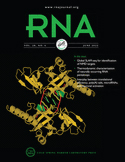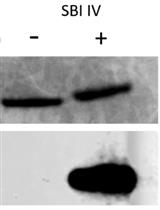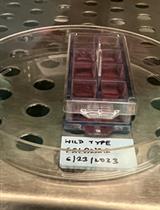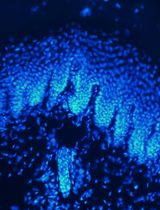- EN - English
- CN - 中文
High-throughput Assessment of Mitochondrial Protein Synthesis in Mammalian Cells Using Mito-FUNCAT FACS
使用 Mito-FUNCAT FACS 对哺乳动物细胞中线粒体蛋白合成进行高通量评估
发布: 2023年02月05日第13卷第3期 DOI: 10.21769/BioProtoc.4602 浏览次数: 1773
评审: Gal HaimovichBrian M. ZidAnonymous reviewer(s)
Abstract
In addition to cytosolic protein synthesis, mitochondria also utilize another translation system that is tailored for mRNAs encoded in the mitochondrial genome. The importance of mitochondrial protein synthesis has been exemplified by the diverse diseases associated with in organello translation deficiencies. Various methods have been developed to monitor mitochondrial translation, such as the classic method of labeling newly synthesized proteins with radioisotopes and the more recent ribosome profiling. However, since these methods always assess the average cell population, measuring the mitochondrial translation capacity in individual cells has been challenging. To overcome this issue, we recently developed mito-fluorescent noncanonical amino acid tagging (FUNCAT) fluorescence-activated cell sorting (FACS), which labels nascent peptides generated by mitochondrial ribosomes with a methionine analog, L-homopropargylglycine (HPG), conjugates the peptides with fluorophores by an in situ click reaction, and detects the signal in individual cells by FACS equipment. With this methodology, the hidden heterogeneity of mitochondrial translation in cell populations can be addressed.
Keywords: Mitochondria (线粒体)Background
Mitochondria are important power plant organelles that produce ATP through oxidative phosphorylation (OXPHOS). Since the symbiosis of the bacterial ancestor, the mitochondrial genome has been minimized due to gene transfer to the nuclear genome. In humans, the organelle genome contains only 13 mRNAs, which all encode a subunit of OXPHOS complexes(Anderson et al., 1981). Despite the small number of mRNAs, their translation by mitochondrial ribosomes (mitoribosomes) is essential since defects in organello translation lead to several diseases, such as mitochondrial myopathy, encephalopathy, lactic acidosis, stroke-like episodes, and myoclonus epilepsy associated with ragged-red fibers (Gorman et al., 2016).
Therefore, mitochondrial translation has been researched by several methods [see Apostolopoulos and Iwasaki (2022) for a summary], such as35S-methionine-labeling of newly synthesized nascent chains (Chomyn, 1996;Sasarman and Shoubridge, 2012), the quantification of ribosome-associated mRNAs by quantitative reverse transcription-PCR (Antonicka et al., 2013; Fung et al., 2013; Zhang et al., 2014; Pearce et al., 2017), ribosome profiling (Rooijers et al., 2013; Iwasaki et al., 2016; Gao et al., 2017; Pearce et al., 2017; Morscher et al., 2018; Suzuki et al., 2020; Kashiwagi et al., 2021; Li et al., 2021; Schöller et al., 2021), and pulse stable isotope labeling by amino acids in cell culture for proteomic analysis (Imami et al., 2021). However, these approaches provide averaged data for thousands of cells, which are pooled for the experiments, and thus pose an analytic hurdle when assessing mitochondrial translation in each individual cell.
However, an alternative method may overcome this barrier. In this technique, click-reaction-compatible methionine analogs, such as L-homopropargylglycine (HPG) and L-azidohomoalanine (AHA), are employed for nascent chain labeling. Subsequent fluorophore conjugation with the click reaction monitors mitochondrial protein synthesis (fluorescent noncanonical amino acid tagging, FUNCAT) (Dieterich et al., 2010). By shutting off cytosolic translation with compounds (such as anisomycin), only the proteins synthesized in the mitochondria (mito-FUNCAT) are labeled (Zhang et al., 2014; Estell et al., 2017; Yousefi et al., 2021; Zorkau et al., 2021). In addition to the in vitro click reaction and subsequent detection on a gel (on-gel mito-FUNCAT), in situ fluorophore conjugation provides visualization of mitochondrial protein synthesis in each cell under a microscope (in situ mito-FUNCAT) (Zhang et al., 2014; Estell et al., 2017;Yousefi et al., 2021;Zorkau et al., 2021).
Recently, we further modified the in situ mito-FUNCAT to perform high-throughput measurements by applying fluorescence-activated cell sorting (FACS) on a massive number of cells (mito-FUNCAT FACS) (Kimura et al., 2022). In this manuscript, we describe the step-by-step protocol of this method, which is applicable to various cell lines. We added Cy3 to HPG-labeled polypeptides and simultaneously stained Tom20 with Alexa-Fluor 647 (AF 647) by immunostaining. Given that the abundance of Tom20 represents the mitochondrial mass and allows mitochondrial protein synthesis to be normalized, this method ensures that the alteration of synthesized protein originates from mitochondrial biogenesis or net translation. Moreover, with mito-FUNCAT FACS, the unexpected cellular heterogeneity of mitochondrial translation in cell populations can be determined. The application of this method will provide pivotal insights into the regulatory mechanisms of mitochondrial protein synthesis across cell types, development, stress response, etc.
Materials and Reagents
Falcon 25 cm2 rectangular canted neck cell culture flask with plug seal screw cap (Corning, catalog number: 353082)
Nunc EasYDish dishes 100 mm (Thermo Fisher Scientific, catalog number: 150466)
Primaria 25 cm2 rectangular canted neck cell culture flask with vented cap (Corning, catalog number: 353808)
Safe lock tubes 2.0 mL (Eppendorf, catalog number: 3-7353-04)
Tube, 15 mL, PP, 17/120 mm, conical bottom, cellstar, blue screw cap, natural, graduated, writing area, sterile, 5 psc./bag, triple packed (Greiner Bio-One, catalog number: 188271)
Pipette, 10 mL, graduated 1/10 mL, sterile, paper-plastic packaging, single packed (Greiner Bio-One, catalog number: 607180)
Pipette, 25 mL, graduated 2/10 mL, sterile, paper-plastic packaging, single packed (Greiner Bio-One, catalog number: 760180)
10 μL, long filter tip, graduated, system rack (PP), sterilized (WATSON, catalog number: 1252P-207CS)
20 μL, hyper filter tip, refill plate, sterilized (WATSON, catalog number: 127-20S)
200 μL, hyper filter tip, refill plate, sterilized (WATSON, catalog number: 0127-20S)
1,000 μL, long filter tip, graduated, refill plate, sterilized (WATSON, catalog number: 126-1000S)
Falcon 5 mL round bottom polystyrene test tube, with snap cap, sterile (Corning, catalog number: 352058)
Falcon 5 mL round bottom polystyrene test tube, with cell strainer snap cap (Corning, catalog number: 352235)
Stericup quick release-GP sterile vacuum filtration system (Millipore, catalog number: S2GPU01RE)
A375 [American Type Culture Collection (ATCC), catalog number: CRL-1619]
C2C12 (ATCC, catalog number: CRL-1772)
H1944 (ATCC, catalog number: CRL-5907)
H2009 (ATCC, catalog number: CRL-5911)
H2122 (ATCC, catalog number: CRL-5985)
H441 (ATCC, catalog number: HTB-174)
HEK293 (ATCC, catalog number: CRL-1573)
HEK293T (ATCC, catalog number: CRL-3216)
HeLa S3 (RIKEN BioResource Research Center, RCB1525)
Alexa-Fluor 647 Anti-Tom20 antibody (Abcam, catalog number: ab209606, stored at 4°C)
Anisomycin (from Streptomyces griseolus) (Chem-Impex International, catalog number: 00466, stored at -20°C)
10× Click-iT cell reaction buffer (Thermo Fisher Scientific, catalog number: C10269, stored at 4°C)
Click-iT reaction buffer additive (Thermo Fisher Scientific, catalog number: C10269, stored at -20°C)
Copper (II) sulfate (CuSO4) (Thermo Fisher Scientific, catalog number: C10269, stored at 4°C)
Cy3-azide (Jena Bioscience, catalog number: CLK-046, stored at -20°C)
Digitonin (Nacalai Tesque, catalog number: 19390-91, stored at room temperature)
DMEM, high glucose, GlutaMAX supplement (Thermo Fisher Scientific, catalog number: 10566-016, stored at 4°C)
DMEM, high glucose, no glutamine, no methionine, no cystine (Thermo Fisher Scientific, catalog number: 21013-024, stored at 4°C)
Dimethyl sulfoxide (DMSO), nuclease and protease tested (Nacalai Tesque, catalog number: 09659-14, stored at room temperature)
L-homopropargylglycine (HPG) (Jena Bioscience, catalog number: CLK-1067, stored at -20°C)
Fetal bovine serum (FBS) (Sigma-Aldrich, catalog number: F7524, stored at -20°C)
1 mol/L HEPES-KOH buffer solution (pH 7.5) (Nacalai Tesque, catalog number: 15639-84, stored at room temperature)
Intercept (TBS) blocking buffer (LI-COR, catalog number: 927-60001, stored at 4°C)
200 mmol/L L-alanyl-L-glutamine solution (100×) (Nacalai Tesque, catalog number: 04260-64, stored at 4°C)
L-cystine dihydrochloride, animal-free (Nacalai Tesque, catalog number: 13003-12, stored at room temperature)
1 mol/L magnesium chloride solution (MgCl2), sterile-filtered (Nacalai Tesque, catalog number: 20942-34, stored at room temperature)
4% paraformaldehyde phosphate buffer solution (Nacalai Tesque, catalog number: 09154-85, stored at 4°C)
5 mol/L sodium chloride solution (NaCl) (Nacalai Tesque, catalog number: 06900-14, stored at room temperature)
Sucrose, ultra-pure (Wako, catalog number: 198-13525, stored at room temperature)
Triton X-100 (Nacalai Tesque, catalog number: 12967-32, stored at room temperature)
Trypsin-EDTA (0.05%), phenol red (Thermo Fisher Scientific, catalog number: 25300-054, stored at 4°C)
UltraPure DNase/RNase-Free distilled water (Thermo Fisher Scientific, catalog number: 10977-015, stored at room temperature)
Bovine serum albumin (Sigma-Aldrich, catalog number: A4919)
Met-free DMEM (500 mL) (see Recipes)
100 mg/mL anisomycin (250 µL) (see Recipes)
100 mM HPG (6.11 mL) (see Recipes)
Met-free DMEM with anisomycin and HPG (10 mL) (see Recipes)
Met-free DMEM with anisomycin (10 mL) (see Recipes)
0.5% digitonin (10 mL) (see Recipes)
Mitochondria-protective buffer (5 mL) (see Recipes)
Mitochondria-protective buffer with 0.0005% digitonin (5 mL) (see Recipes)
10% Triton X-100 (40 mL) (see Recipes)
PBS with 0.1% Triton X-100 (0.5 mL) (see Recipes)
5 mM Cy3-azide (370 µL) (see Recipes)
50 µM Cy3-azide (100 µL) (see Recipes)
Click-reaction mixture (1 mL) (see Recipes)
Intercept (TBS) blocking buffer with Alexa-Fluor 647 Anti-Tom20 antibody (101 µL) (see Recipes)
FACS buffer (see Recipes)
Equipment
High-speed micro centrifuge (himac, model: CF16RN)
High-speed refrigerated micro centrifuge (TOMY, model: MDX-310)
Swing rotor (himac, model: T4SS31)
Swing rack (TOMY, model: SAR015-24)
CO2 incubator (PHCbi, model: MAC-170AIC)
Pipet-Aid XP2 (Drummond Scientific Company, catalog number: 4-040-501)
Pipetman P-10 (Gilson, catalog number: F144802)
Pipetman P-20 (Gilson, catalog number: F123600)
Pipetman P-200 (Gilson, catalog number: F123601)
Pipetman P-1000 (Gilson, catalog number: F123602)
BD FACSMelody [BD, 3-laser (488, 640, and 561 nm), 8-color (2-2-4) configuration)]
CellDrop BF (DeNovix, CellDrop BF-UNLTD)
Software
BD FACSChorus (BD FACSMelody operating software)
FlowJo (BD, v10.8.1)
R version 4.1.1 (R Development Core Team, https://www.r-project.org )
Procedure
文章信息
版权信息
© 2023 The Author(s); This is an open access article under the CC BY-NC license (https://creativecommons.org/licenses/by-nc/4.0/).
如何引用
Saito, H., Osaki, T., Ikeuchi, Y. and Iwasaki, S. (2023). High-throughput Assessment of Mitochondrial Protein Synthesis in Mammalian Cells Using Mito-FUNCAT FACS. Bio-protocol 13(3): e4602. DOI: 10.21769/BioProtoc.4602.
分类
分子生物学 > 蛋白质 > 流式细胞术
细胞生物学 > 细胞染色 > 蛋白质
您对这篇实验方法有问题吗?
在此处发布您的问题,我们将邀请本文作者来回答。同时,我们会将您的问题发布到Bio-protocol Exchange,以便寻求社区成员的帮助。
Share
Bluesky
X
Copy link













